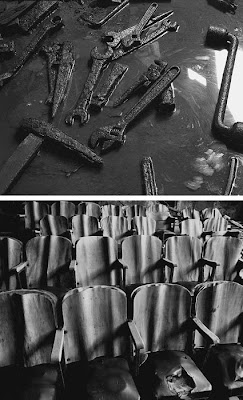OK this one was taken from www.pushpullbar.com
published by some guy nicknamed "dhaa" under the subjet of death cities,
I found this story very amusing is about a town (which is an island too) that from one day to another was abandoned and now somehow its forbidden to be there. Somehow this guy had the chance to go and here and here is his testimonial
for more information go to Gunkanjima.com it contains 3d model of the island and the list of people who visited it personally after it was prohibited to go therePhotos from Christoph Klemmt's travel to the islandand.
Hashimajima/Gunkanjima/The Battleship Island, Japan
The following text is taken from Yuji Saiga's website. The site contains lots of Yuji's photos from the last days of Gunkanjima as well as from the island already deserted
Off the westernmost coast of Japan, is an island called "Gunkanjima" that is hardly known even to the Japanese. Long ago, the island was nothing more than a small reef. Then in 1810, the chance discovery of coal drastically changed the fate of this reef. As reclamation began, people came to live here, and through coal mining the reef started to expand continuously. Before long, the reef had grown into an artificial island of one kilometer (three-quarters of a mile) in perimeter, with a population of 5,300 inhabitants. Looming above the ocean, it appeared a concrete labyrinth of many-storied apartment houses and mining structures built closely together. Seen from the ocean, the silhouette of the island closely resembled a battleship - so, the island came to be called Gunkanjima, or Battleship island.
I was twenty-two when I first visited the island I had dreamed about ever since childhood. Much like a fortress built upon the sea, surrounded by high walls,the island possessed an air of a small kingdom, where its denizens boasted "There is nothing we don't have here." They were right. They did have everything within their miniature kingdom - except a cemetery. But, the irony of this one shortcoming was proven by the passage of time. The island had already been doomed to turn into an enormous graveyard.
Eventually, mining on the island came to an end, and in 1974 the world's once most densely populated island became totally deserted. After all its inhabitants departed leaving behind their belongings, the island became an empty shell of a city whose inhabitants disappeared overnight, as if by some mysterious act of God.
Ten years later, I returned to the island, equipped with food and drinking water. The island was devastated, with the smell of people gone. Inside the buildings, however, evidence of people's lives distinctly remained. The strange atmosphere led me to wonder if island had remained in a state of sleep ever since all its inhabitants left.

As days passed on the island, my impression of it began to change greatly. The innumerable articles left behind, all shrouded in dust and rusted, at first seemed to be merely drifting toward death. Yet, after some time, they started to look vivid and beautiful. I thought perhaps the island, while appearing to have fallen into a deep asleep, had actually gradually started to awaken on the day it was deserted.
 The order and values that prevailed only through human existence had long been disrupted. Items were scattered here and there with no context, no ranking. Everything had equal value. The sights I saw spoke of the relationship of the master and servant a relationship that had vanished at the time these items were discarded, liberating them from human reign. To be abandoned meant freedom from all. The items left behind on the island lost their names, their given tasks, even the meaning of their existence. They lay there as mere "objects." Books and clocks and empty bottles were no longer books and clocks and empty bottles. Things that had been domesticated by humans no longer existed on the island.
The order and values that prevailed only through human existence had long been disrupted. Items were scattered here and there with no context, no ranking. Everything had equal value. The sights I saw spoke of the relationship of the master and servant a relationship that had vanished at the time these items were discarded, liberating them from human reign. To be abandoned meant freedom from all. The items left behind on the island lost their names, their given tasks, even the meaning of their existence. They lay there as mere "objects." Books and clocks and empty bottles were no longer books and clocks and empty bottles. Things that had been domesticated by humans no longer existed on the island.Just as the inhabitants started their lives anew by leaving the island, these things left behind on the island also shed their identities once forced on by humans, to start their lives as "pure objects."
LEAVE A COMMENT!!!







2 comentarios:
a good piece with food for thought. the last paragraphs really strikes me.Its like with the existence of humans, these objects are functional, clocks would show time, books are source of knowledge. As human are leaving, these objects would just remain as it is. Just as we are, with God, we are His creation. Outside God's presence, we are merely a sand, the pure objects. And this again reminds me of Mies Van De Rohe's famous quote " God is in Detail", architecturally and spiritually. good post!
no me quiero llamar alejandra dice:
puuuuuto
no me quiero llamar alejandra dice:
el que no brinque el que no salte
Fernanda dice:
jajajaja
Publicar un comentario